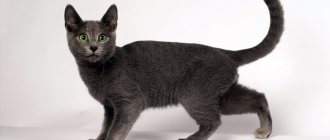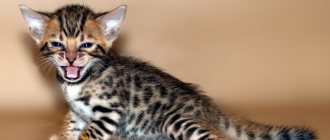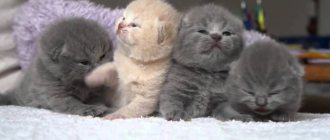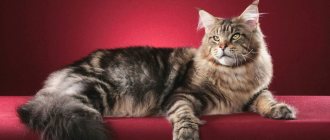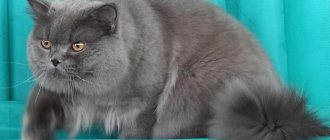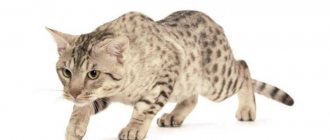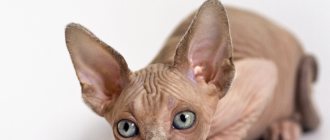History of the Russian Blue cat breed
The origins of this breed are very controversial. According to one version, English sailors standing with their ship in Arkhangelsk noticed an unusually beautiful cat in the vicinity of the city and took it on board with them. According to another version, the animals, on the contrary, escaped from an English ship and took root in the northern port.
There is no information that would confirm either of these versions. The subsequent development of the breed was carried out in England. Since 1893, breeding began with animals probably brought from Russia. In 1935, the first standard was registered, which marked the official appearance of the breed.
The First World War put the animal in danger of extinction. To preserve the breed, the British crossed it with Siamese cats - their characteristics can still appear in modern Russian Blues today.
The restoration of the breed continued only in the 20th century, already by the Americans, and only in the 70s did the Russian blue cat regain its original appearance, and in the 80s it returned to Russia again.
Description of the breed
The breed originates in Russia. In 1893, cat breeder Karen Cox from the city of Arkhangelsk took several Russian Blue kittens to England, and from that time active breeding work with these animals began.
The breed was practically lost after the Second World War, but lovers of these cats began to pay more attention to breeding. Soon, worthy representatives of the Russian Blue appeared in Russia again.
Pets have a graceful physique, a slightly elongated body and fairly light bones. The head is wedge-shaped, long, the muzzle is narrow. The ears are large and wide at the base. The eyes have an almond-shaped cut, the color of the iris is strictly bright green.
The coat is short, double (hair and undercoat), can only have a blue color, a silver tint (gray) is desirable. Serious disadvantages include the presence of white spots on the body, rough bones, large head, and yellow eyes.
The color must be exclusively blue. Preferably with a silver tint
Breed standard Russian Blue cat
The following description of the standards suits the appearance of the Russian Blue cat:
- Adult weight: 3-7 kg.
- The body is strong, muscular, long. The body shape is elegant.
- The paws are thin and long.
- The tail is long, maintaining proportions to the body.
- The head is wedge-shaped with a flat and long profile, the nose is without a break.
- The ears are set wide apart, wide at the base and tapering towards the tips, long.
- The eyes are round, green, and spaced apart.
- The coat feels plush to the touch, is soft, thick, and short. The coat has a double structure and does not adhere to the body.
The long-haired variation of the cat does not meet the standards; it belongs to a separate rare breed - the Nibelung.
Description of the breed
The Russian Blue cat is of medium size, although the body is elongated. But still, the cat, despite its well-developed muscles and strength, looks very elegant and harmonious. And this Russian beauty moves very easily and naturally.
Her fur is like silver, it shimmers so beautifully. The color is even blue, although the silver stripes only add beauty. Short, but very thick, even springs a little when stroked, which is why the Russian Blue cat looks like a plush toy.
The disadvantages include not only the uneven gray-blue color (although stripes are allowed in babies, but over time the color should become one), but also the “sleek” coat (not springy).
The face is small, short, can be round or slightly angular (resemble a square), but there are also some small characteristics of the breed. The chin is “strong-willed”, some call it powerful.
But the pads where the antennae grow are perfectly designed, which gives the cat a special look. The ears are pointed, and the nose is medium, straight (not snub-nosed, not flattened).
The eyes are striking: bright green, like emeralds, set wide apart. But according to the standard, their shape can be different: almond-shaped (British) and round (American). It is considered a disadvantage if there are yellow spots on the iris.
The “disadvantages” include the bulging of the eyes, their deep setting, and excessive roundness.
The tail is long, not fluffy, becoming thinner towards the tip. The paws are graceful and long, and the color of the toe pads again depends on the standard: blue according to the British and pink according to the American. A too “heavy” skeleton is considered a disadvantage if the cat does not look harmonious (too short or thick paws).
Colors of the Russian Blue cat
It is enough to look at a photo of a cat to understand that this graceful pet has an unusual deep blue coat color all over its body. Preference among breeders and experts is given to light colors. Other colors of the animal are not allowed by the standards.
The guard coat has a clearly visible tipping at the ends, creating the effect of a shiny coat. There should be a visible contrast between the main hair color and the silver tips. In general, the color of the animal’s coat is uniform; stripes are not allowed by the breed standard.
Separately, it should be noted the unusual color of the cats’ eyes. Bright green, all shades of emerald - other colors are rejected.
Pros and cons of the breed
The main advantages of this breed: luxurious silver coat, rich emerald eyes, miniature body and long legs.
Minuses:
- fractures in the tail area;
- sagging of the spine;
- crooked jaw;
- malocclusion;
- small height.
Even if your pet has such defects, he will be able to live fully into old age. Such problems play a significant role if a person bought a kitten for further breeding.
Character of the breed Russian Blue cat
The character of the Russian Blue is somewhat stubborn: it will obey only one owner, while preferring independence. However, wandering on the street is not at all typical for her - she is truly a pet.
This breed behaves cautiously and modestly with guests in the house; it will not be the first to make contact. With its owner, the Russian Blue cat is open and loyal, does not bother him, and is never intrusive. If you already have other animals at home, even small ones like a degu or a chinchilla, rest assured that the new pet will get along well with them.
If you read the reviews of the owners, many note the high intelligence of their pets: cats very quickly begin to understand the gestures and words of the owner. And when playing with a person, they release their claws, playing exclusively with their soft paws.
Place for a kitten in the house
Purchasing a Russian Blue kitten is hardly a spontaneous decision. Therefore, before the baby arrives in the house, his place must be arranged and everything necessary for maintenance and care must be prepared.
At least three stainless steel or earthenware bowls: short for wet food, medium for dry croquettes, deep for water.
A litter tray, or better yet two - one smaller one will be needed for the kitten in the first months of life, and the second one will be used by the kitten as an adult. As a rule, kittens, when leaving their first home, are already litter box trained and all that remains is to decide which brand of litter to use. It is quite possible to accustom a kitten to an empty tray with a grid - it is useful and hygienic: the filler granules will not fly away in all directions and be carried around the apartment by their paws. In this case, the task of neutralizing the odor is always solved by a cleanly washed tray.
Hygiene items - brushes and combs, a rubber brush for combing out dead hair, nail clippers, a suede cloth for polishing, a toothbrush for animals, the necessary set of pet products and towels for washing. The owner must take care of the cleanliness of all these accessories in the same way as his own. A Russian Blue cat should be accustomed to grooming from childhood, and then trimming its claws or another bath will not be a shock for either the animal or the person.
Toys are a mandatory and important component of the kitten’s socialization process. With equal pleasure, the little mermaid will chase both an ordinary bow on a braid and the beam of a laser pointer.
Therefore, what matters is not how expensive or technically advanced the toy is. The main thing is that it is not traumatic (breakable, cutting, heavy) and has a suitable size: a kitten that is too large will not be interested, a small one can be swallowed. Russian Blue kittens in their usual environment are usually very active, playful and do not lose these qualities with age.
Games help you hone your technique for moving gracefully through space.
A scratching post is also a familiar item for a nursery graduate. The owner has the choice of design and size - from a modest column covered with rope to a multi-level playroom complex - this absolutely necessary device.
A carrying bag is indispensable as a means of transport for visits to the veterinarian, trips and travel.
A bed is sometimes not considered a necessary item: about 90% of surveyed cat owners allow their pets to sleep in their bed. But still, the Russian Blue should have an individual place to sleep, to which the animal must be accustomed from childhood. “Put a piece of paper in the middle of a football field, and sooner or later a cat will lie on it”: purrs love to lie on something, be it the owner’s favorite designer blouse or a stack of freshly ironed linen. And Russian Blues are no exception.
To avoid such unpleasant surprises, you will need a crib or basket for the baby. Other useful items - harnesses for walking and swimming, a collar with an address medallion, warming and antistatic bedding - can be purchased later.
Cats use their sense of smell to a greater extent than their other senses to navigate unfamiliar environments. Having gotten used to the smell inherent in the owner and relating it to a calm environment, the baby will quickly get used to the new home and begin to enthusiastically explore the new space. There is no need to prevent this, but such educational excursions should not take place unsupervised.
The owner must use every opportunity for communication and joint games, not forgetting the words of encouragement for any, even the smallest, achievement of the baby. Very soon the kitten will begin to associate home and family with the most pleasant sensations - delicious food, love, a sense of comfort and security.
Maintenance and care of the Russian Blue cat
The Russian Blue is one of the least problematic animals to keep. She is not characterized by the habit of marking her territory; she is very clean. But you should constantly monitor the cleanliness of the litter box: if you do not clean it in time, the cat will not go into it, but will begin to do its business in other places.
The Russian Blue's short coat requires minimal grooming. Once a week, comb out your cat's dead undercoat with a furminator or slicker brush. It is not recommended to touch the tail: the hair combed there takes much longer to recover, and because of this the tail will appear short.
To add shine to the coat, after combing, you can polish it with a piece of fur or a suede patch.
Defects of the Van breed
Furry cats have strong health, but any animal can get sick. Often owners of purebred cats discover the disease too late. To avoid this, you need to undergo preventive examinations at a veterinary clinic. An experienced specialist can conduct tests and identify the disease. In addition, regular visits to the veterinarian will not allow you to miss mandatory vaccinations.
no cat is immune from disease
Tendency to diseases
It is difficult to say that Vans are prone to any particular disease. But your pet is not immune from diseases common to domestic cats. The most common condition in cats is hypertrophic cardiomyopathy. It is very difficult to detect this disease at an early stage; the disease can progress over several months. Therefore, you need to take a closer look at the animal’s behavior. You should immediately contact your veterinarian if you notice the following symptoms:
- shortness of breath (difficulty breathing, the cat breathes with its mouth open);
- rapid breathing;
- lethargy or drowsiness;
- loss of appetite and water intake;
- heart murmurs.
In addition, any purebred cat can get sick due to improper care (insufficient brushing of teeth, improper diet, etc.). Also, do not forget about the possibility of “picking up” an infection or parasites. Therefore, the following symptoms are common indications for contacting a veterinarian:
- tartar, bad breath, red or inflamed gums, or broken teeth;
- itching, scratching, hair loss. The cat constantly licks the same place or chews its fur;
- fear, aggression, behavioral changes;
- the cat constantly shakes its head or ears;
- red or cloudy eyes;
- difficulty urinating, colorless urine;
- exercise intolerance, increased fatigue;
- sudden attacks of weakness.
If you think your cat looks sick or sad, you should contact your veterinarian
One of the most dangerous diseases is arterial thromboembolism in cats. Thromboembolism causes blood clots that can block large blood vessels. Blood circulation may be impaired and your pet's hind legs may fail. Moreover, a paralyzed limb does not necessarily lose sensitivity. Sometimes when touching the failed paw, the cat may experience pain. The limb feels cold to the touch. If this happens, you should immediately contact a veterinary clinic. This is a fatal disease, so there is not a minute to waste. As a rule, even after treatment, the functionality of the limb is not restored. But timely and competent treatment of heart disease will save your pet’s life.
Defects in appearance
Some people who do not understand cat breeds may be surprised when they see a Turkish Van for the first time. Eyes of different colors can be perceived as a mutation. However, heterochromia is the norm for the Turkish Van. The difference in eyesight of a fluffy cat is not a disease, because the animal’s vision is fully preserved. Therefore, the defects in the appearance of the Turkish Van include those deviations that usually serve as a reason for disqualification from the exhibition. And sometimes, due to the presence of a defect, a cat is not allowed to participate at all:
- any signs of abnormal body shape (too short stocky body, too slender, thin bones);
- more than 20% white on the tail or colored areas of more than 15% of the body area (excluding head and tail);
- flat profile or too obvious bend of the nose;
- complete absence of colored markings in the area from eye level to the back of the head or on the tail;
- genetic or skeletal defects (flattened chest, tail defects, incorrect number of toes);
- strabismus, blindness.
Feeding the Russian Blue cat
Like other breeds, baby pets need to be fed more often than adults - 3-5 times a day. After a year, the cat is considered an adult and can be switched to two meals a day.
It is best to feed the animal with high-class dry and wet food (premium, super premium). Good food takes into account all the cat’s needs for vitamins and microelements.
Feeding only natural foods can make it difficult to calculate the required nutrients in the diet. Good results can be achieved with a mixed type of feeding, combining industrial feed and natural meat. Do not forget that you cannot feed your pets human food from the table.
At what age is it recommended to get vaccinated?
Distemper is considered a particularly dangerous cat disease. It is practically impossible to cure a sick animal; death occurs in 90% of cases. Vaccination against the disease is mandatory and is done at an early age.
The feline herpes virus also often affects representatives of the breed. The disease is difficult to diagnose, the form becomes chronic, and the likelihood of death without vaccination is high.
Another dangerous fatal disease is rabies. The disease affects the brain and spinal cord, is contagious, and is therefore dangerous for both the animal and its owner.
Important! The first vaccinations should be given to the animal by 8-10 weeks of age. These should be vaccines against calcivirosis, feline herpes virus and panleukopenia.
Repeated vaccination is organized when the kitten is 12 weeks old. The drugs used must be identical to the vaccines supplied for the first time.
Pet vaccination
When organizing vaccinations, it is important to follow the schedule established by the veterinarian. Each vaccination must be included in a special document. Any cat health problem can be a reason to avoid vaccination. The decision to withdraw is made by the veterinarian.
Health and disease of the Russian Blue cat
The Russian Blue cat is a native breed, bred naturally, which has a positive effect on its health. The breed has strong immunity. Its northern roots and warm undercoat make it resistant to cold and drafts.
With proper balanced nutrition, timely visits to the veterinarian, proper care of the ears, eyes and claws, Russian Blue cats remain vigorous and healthy for up to 20 years. On average, the life expectancy of this breed is 15-16 years.
If the cat was purchased as a pet, and mating and pregnancy are not planned, be sure to sterilize it: this will have a beneficial effect on its health and quality of life.
Appearance
The Russian Blue is somewhat similar in appearance to the British and Scottish Fold cats; there are a number of features.
The standards for this breed include:
- long legs;
- wool that is plush to the touch;
- big round eyes.
This cat is aware of all its beauty, so it tries to demonstrate it. As soon as she notices that people are looking at her, she lies down and stretches out her slender paws.
Head
It has a large head, which is wedge-shaped with 7 planes. The rough cheekbones of the animal stand out especially. But it all depends on how much your pet weighs; of course, if it gains weight, the cheekbones will become a little softer.
Cat weight
Once the kitten is 9-10 months old, its weight reaches 2-3 kg. In the future, he remains the same weight, after 3 years he may gain a little weight. On average, males and females do not grow more than 3-4 kg. If you sterilize an animal, its weight can increase even 1.5 times.
Frame
The skeleton is as thin as possible, the body is long, but still strong. At first glance, no one would think that such a cat is an excellent hunter. Although in fact, it is his grace and light weight that help him move quickly and keep up with even the fastest rodents.
Color
They have only one color, blue. The brightly contrasting silver tipping is considered especially valuable. Each hair has a slightly silvery tip that resembles “frost.” In the sun, such wool especially sparkles.
Under the Christmas tree
Advantages and disadvantages of the Russian Blue cat
Advantages of the breed:
The Russian Blue cat can be called an ideal companion for humans. They calmly endure loneliness, go about their business or sleep. Excellent health and exemplary behavior will also be big advantages for the future owner of the cat.
This breed is considered to be hypoallergenic - the likelihood of an allergic reaction to it is much less likely than to regular cats.
Disadvantages of the breed:
Cats are afraid of loud sounds, so if noisy groups often gather in your apartment, take care of a secluded place for your pet where he can hide.
Interesting Facts
Over the years of the breed’s existence, many interesting things have been associated with it:
- Blue cats were regular participants in Harry Houdini's tricks. The legendary magician considered them the most intelligent and magnetic of all known breeds.
- Peter I was a passionate admirer of cats with an ash-blue coat. His pet, nicknamed Vaska, could move around the palace without hindrance.
- At first, representatives of the breed were nervous and timid, for which the Russian Blue was nicknamed the “wild gray rabbit.” As a result of targeted selection, this deficiency was eliminated.
Price of Russian Blue cat
Potential buyers will probably want to know how much this green-eyed beauty costs. Depending on age, gender and breed data, the price of a cat with a pedigree ranges from 10,000 to 40,000 rubles. The cost of an animal for breeding is much higher - up to 70,000 rubles.
There are many offers for selling kittens at low prices on Avito. If you want to save money, be careful - you can fall for an ad from a scammer who will sell you an ordinary yard kitten with a similar color instead of a purebred animal.
Education and physical activity
The Russian Blue is distinguished by high intelligence and good memory. She is easy to train and quickly gets used to the tray and scratching post. If desired, the cat can be taught not only basic skills, but also simple tricks.
Russian Blues are very curious creatures that love to explore new things, so cats of this breed can be walked on a leash. If an animal is constantly kept in an apartment and does not have access to the street, a multi-tiered play labyrinth must be equipped for it.
Popular nicknames of the Russian Blue cat
For a regal and aristocratic Russian Blue cat, the owner needs to choose an appropriate name. Very popular nicknames for this breed are:
- for cats: Daphne, Blue, Viola, Bella, Whiskey;
- for a cat: Silver, Topaz, Sapphire, Velvet, Gray.
If you get rid of all the conventions, then a name for a blue kitten can be not only elegant, but also funny.
Breeding Features
Females of the Russian Blue breed mature at 6–8 months, but veterinarians advise delaying the first mating until one and a half years. Pregnancy usually proceeds without complications. Its duration is 63–68 days. There are from 3 to 6 kittens in one litter.
Kittens aged 5 weeks
The cat knows how to take care of her cubs. At first, she tries to hide them from prying eyes. Feeling a threat, she will protect the offspring - she will hiss and fight. Children need to be warned about the danger and asked not to touch the kittens. Mom feeds, licks the babies and raises them. As soon as their eyes open, the cat will teach them how to use the litter box.
Molting in a Russian Blue cat
In spring and autumn, cats change their coat, this process is called seasonal molting. But due to the inclusion of heating and artificial lighting in the apartment, the animal’s biorhythms are disrupted, which leads to a constant change of coat.
During seasonal shedding, it is recommended to brush your cat three times a week to remove excess undercoat. If your pet is comfortable with bathing, you can wash it: the water will easily wash away excess hair.
In the off-season, you can add products containing vitamin A, which is responsible for the quality of the animal’s coat, to the diet of the Russian Blue cat. It is found in carrots, egg yolks and fish oil.
Character and temperament
The blue cat is endowed with a tactful, calm disposition. An intelligent animal never imposes its company and feels great alone. A cat of this breed does not like noisy companies and avoids contact with strangers.
If strangers come to the house, she will hide until the guests leave.
A freedom-loving and quiet cat, she has her own opinion and does not tolerate violence. She does not tolerate intra-family quarrels well. Frequent conflicts between owners negatively affect the behavior of the pet, turning it into a frightened and hysterical creature.
Breed and children
The blue cat never loses her composure and is patient with children. Instead of bringing a naughty baby to reason with the help of her claws, she will simply run away and hide from the child.
Breed and other animals
Blue cats are loyal to other pets, especially if they do not try to provoke them. Representatives of the breed get along well with other cats and dogs. But they perceive rodents and birds as prey.
Russian Blue kittens
The Russian Blue cat has very cute and beautiful kittens: fluffy, with a round head, they resemble little bear cubs. The breed characteristics of the pet will be fully formed by the age of one year, but already at 3-4 months you can understand what the kitten will grow into. It is at this age that it is recommended to take a young animal from a breeder.
The kitten's eyes should be pale green, over time they become emerald. The coat should be without white medallions, but a slight stripe of the tail is acceptable, which disappears in an adult.
A pregnant cat should eat well. Make sure there is always food and fresh water in the bowls. Movement will be beneficial for your pet, but you need to limit jumping from high places. In the last weeks of pregnancy, the cat becomes clumsy and may unsuccessfully jump from a height or fall.
Did you like the article? Not good? Then it is possible that you will write yours much better. Just follow the link Posting articles and read the rules for publishing articles on the MultiBlog67.RU website.
Bambino
In the early 2000s, the Osborne couple from Arkansas, USA, acquired a funny cat. It was a sphinx, but with very short legs, and it looked rather miniature. The couple liked their new pet so much that they decided to breed and sell such animals.
Bambino is the result of crossing a munchkin and a sphinx, its weight is between 2-4 kg. Pat Osborne is the author of the title. Translated from Italian, this word means “child”. The breed was registered in 2005, and then it first appeared in Russia.
The official organization TICA does not recognize the bambino as an independent breed, while it is cautiously called experimental. In some countries, such crossbreeding is prohibited as cruelty to animals.


